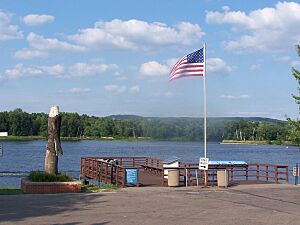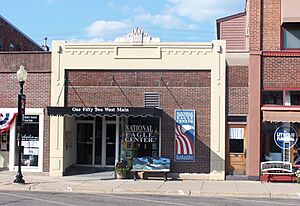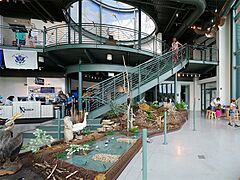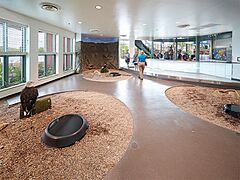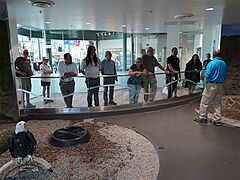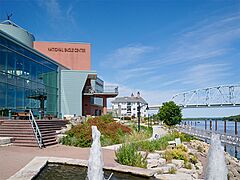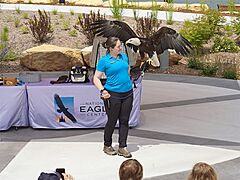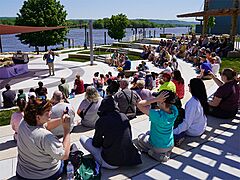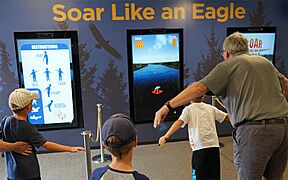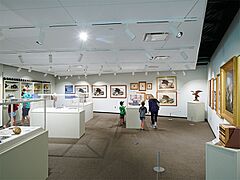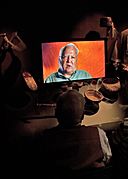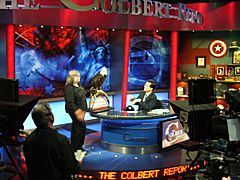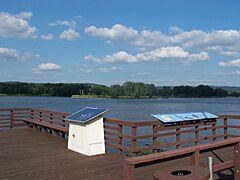National Eagle Center facts for kids
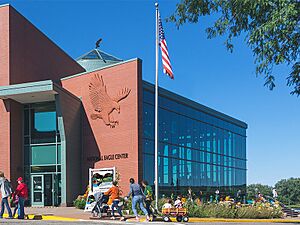
Entrance to National Eagle Center Riverfront Building
|
|
| Established | 1999 |
|---|---|
| Location | 50 Pembroke Ave S. Wabasha, Minnesota, United States |
| Type | Interpretive center |
| Visitors | 85,000 (2018) |
The National Eagle Center is a special place in Wabasha, Minnesota, United States. It's located right by the Mississippi River. This center teaches people all about eagles and the important Upper Mississippi River area.
You can watch wild eagles from viewing decks all year long. The center also has eagles that can't be released back into the wild. These eagles are part of interactive exhibits. You can learn about eagle science and history too!
Contents
History of the Eagle Center
Hundreds of bald eagles gather in Wabasha because of a unique spot where the Mississippi and Chippewa Rivers meet. The Chippewa River creates a natural lake called Lake Pepin. The fast-moving water from the Chippewa River keeps parts of the Mississippi from freezing in winter. This makes it a great place for eagles to find fish.
How the Center Started
In 1989, a group of local volunteers called EagleWatch started. They worked with the Wabasha Chamber of Commerce. They fixed up an old deck where paddleboats used to drop off passengers. This deck became a spot for people to watch bald eagles. In their first winter, over a thousand people came to see the eagles!
EagleWatch became a nonprofit organization in 1989. They worked with the City of Wabasha to get money from the state and federal governments. In 1998, the National Eagle Center received federal recognition. This helped agencies like the U.S. Army Corps of Engineers to assist with its development.
For a short time, the City of Wabasha partnered with the National Audubon Society to manage the center. However, the city later decided to work with EagleWatch again. This was because most of the money raised was going to the National Audubon Society's other programs. The city also wanted to keep the original vision for the Eagle Center. So, in July 2001, EagleWatch took over management again.
First Location and Growth
In 1999, the National Eagle Center opened a temporary center in downtown Wabasha. It was in an old storefront building. This center was open all year. It was home to two live bald eagles, Harriet and Angel. These eagles had injuries and could not live in the wild.
In May 2007, the National Eagle Center opened its current building. It's a large, 14,200-square-foot (1,320 m2) center right on the banks of the Mississippi River. This new building has a special aviary for eagles, exhibits, classrooms, an auditorium, and a gift shop. It offers programs about protecting the environment, Native American history, and the important role of the bald eagle in America.
What You Can See and Do
Meet the Eagle Ambassadors
The National Eagle Center is home to eagles that cannot live in the wild. They are called "ambassadors." These eagles live in a special indoor aviary. It has glass panels so visitors can watch them. Sometimes, visitors can even go inside the aviary!
- Angel - Found with a broken wing in Wisconsin in 1999. Angel arrived at the Center in 2000.
- Was'aka - Blind in one eye due to a tumor. Was'aka arrived at the Center in 2009.
- Latsch - Blind in one eye. Latsch was found in Florida in 2016 and arrived at the Center in 2018.
- Perseus - Had a serious wing injury. Perseus was rescued in Missouri in 2021 and arrived at the Center in 2023.
Past Eagle Ambassadors
- Harriet (Bald eagle) - The first eagle ambassador. Harriet was injured in a car accident in 1998. She passed away in May 2016 at 35 years old.
- Columbia (Bald eagle) - Injured in a car accident and had lead poisoning. Columbia arrived at the Center in 2003. She passed away in January 2024 due to problems from lead exposure.
- Donald (Golden eagle) - Hit by a car, breaking his wing. Donald arrived at the Center in 2008. He passed away in March 2020.
Riverfront Amphitheater
In 2023, the National Eagle Center opened a new Riverfront Amphitheater. This outdoor space can hold about 250 people. It's used for eagle programs in the summer. It also hosts private events and concerts.
Cultural Connections Gallery
This exhibit shows a buffalo hide that tells the Dakota creation story. There's also a video with comments from artist Javier Lara-Ruiz. The gallery includes a land acknowledgment and shares the story of the Dakota People.
American Eagle Gallery
The American Eagle Gallery displays items from the Preston Cook American Eagle Collection. This huge collection has over 40,000 pieces! You can see original art, historical items, and things representing pop culture, business, and the military.
Past Exhibits
- Native American Artifact Exhibit - This exhibit featured old items from Jim Stokes, a descendant of Chief Wapasha III. In a darkened room, lights would shine on an item, and Jim Stokes' recorded voice would tell you about it.
Observation Decks
The center has two outdoor decks for watching eagles. One is 25 feet high, and another is at river level. They have spotting scopes to help you see wild eagles over the Mississippi River. You can also see other wildlife and river boats.
Other Facilities
- Classrooms for learning and group meetings.
- Exhibit areas with preserved animal specimens and birds in flight.
Special Events
SOAR with the Eagles Festival
"SOAR with the Eagles" is a yearly festival. It happens over one weekend in March, June, and September. This festival celebrates the bald eagles' migration along the Mississippi River. It includes watching wild eagles, animal shows, flying bird shows, special exhibits, and educational programs.
Directors of the Center
- Heidi Hughes, 1996-1998
- Mary Beth Garrigan, 2000-2012
- Rolf Thompson, 2012-2019
- Meg Gammage-Tucker, 2020–2023
- Karlin Symons, 2023–present
Gallery


